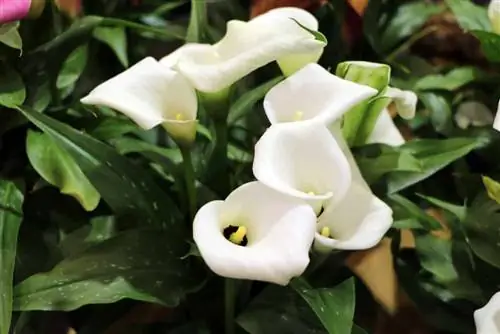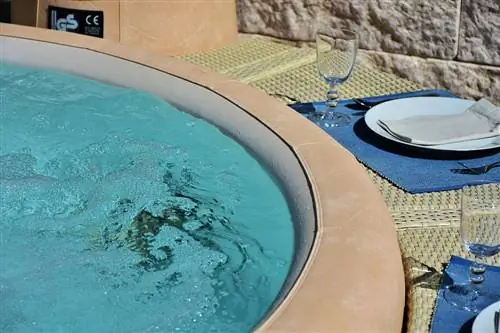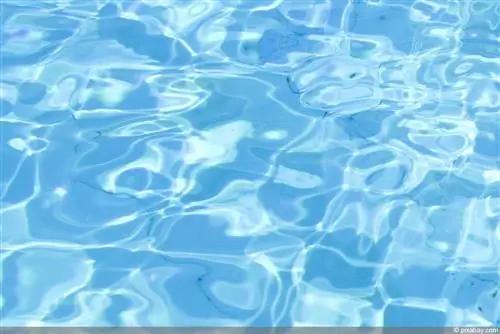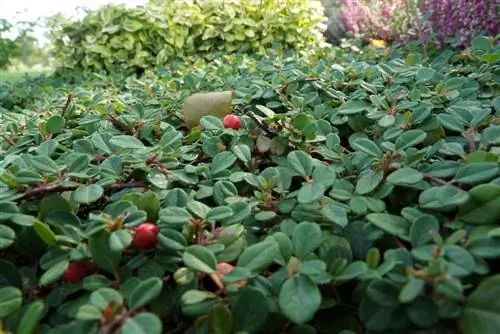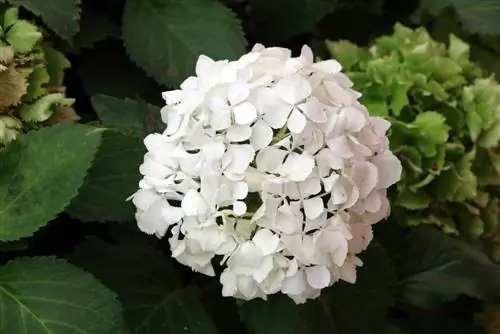- Author admin [email protected].
- Public 2023-12-17 03:39.
- Last modified 2025-06-01 06:48.
Watering plants and flowers in the room often enough is quite easy, just when they need water - say experienced indoor gardeners who can estimate how much water a plant actually needs and who know what the best distances are. But beginners first have to learn to assess all of this, and there are also various exceptional situations:
The normal houseplant
Even with the “normal houseplant”, in a he althy condition and nice and green and strong, a whole range of factors have to be taken into account in order to supply this plant with the right amount and at the right intervals.
The more plants you have already looked after, the better you will be able to instinctively estimate the correct amounts of water and the spacing of watering. Scientists who do not like to rely on instinct, but rather want to develop precise basis for action based on proven facts, would try to determine the factors on which “correct watering” depends and then evaluate them in an attribution analysis. Unfortunately, no one has done this for houseplants, but you don't have to be a scientist to collect the factors that influence a plant's water needs and watering frequency:
- Probably the biggest influence on a plant's water requirements is the biomass that the plant has already developed
- This means the roots as well as the shoots, leaves, flowers above the ground
- Numerous genetically predetermined differences between plant species have a major influence on water consumption
- Small, young plants use a relatively large amount of water because they are programmed to grow (form new cells)
- But once there are just a few leaves to care for, the water requirement is pretty limited
- Larger plants use less water when allowing shoots to mature or become woody
- When budding in spring and during flowering, consumption increases
- Rule of thumb: The bigger the leaves and flowers, the greater the thirst
- Plants in very light locations have a high photosynthesis rate and the associated high water consumption
- In addition, a lot of water evaporates in such locations, just like in rather warm locations, this water also needs to be replaced
- The frequency of watering initially simply depends on consumption
- And then the thought that rain naturally occurs at certain intervals, the plant household is prepared for this
- With some plants very widely spaced in abundant quantities, these succulents store water
- “Normal” plants soak up their cells when it rains, the water remaining in the soil dissolves nutrients that are gradually absorbed
- If you constantly water little, some poorly soluble nutrients cannot be dissolved
So first find out whether a plant needs a lot or a little water, and then give this water in a generous dose at as large an interval as possible. Rather narrowly, you are creating unnecessary work for yourself if you pamper your plants with plenty of water. Always only water when the plants look so limp that they are probably close to letting their leaves droop. Promotes root formation, makes plants robust, can extend flowering and saves water.
The “suffering” houseplant
To keep a houseplant “normal”, you need a lot of knowledge about plants and the living conditions that plants need. Of course, not every person has this right from the start, and in the course of the learning process one or two things go wrong, which can then also influence the casting.
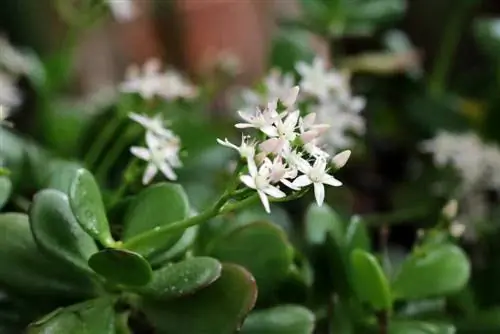
Anytime a houseplant seems to be bitchy or overly fussy about watering, several things should be checked:
Quality and age of the substrate
The quality of the substrate affects the water requirements of a plant after a more or less long period of time:
Substrate as natural as possible
In the best case scenario, the “substrate that is as natural as possible” simply comes from nature. If you have a garden with good, well-maintained garden soil, there is no reason to buy a commercially mixed substrate whose quality you must first check before purchasing. A well-maintained garden soil also increases in number due to the activity of the soil organisms that process plant residues, on mulching areas or on the compost, so you should have no trouble diverting some soil for your houseplant.
This garden soil must now be adjusted to the needs of the corresponding houseplant. These needs depend on the origin of the plants; native plants usually do well with normal garden soil in pots. When imported from foreign countries, the “good garden soil” often has to be made “leaner” by mixing in sand because the plants are used to deficient conditions. It may also be necessary to lower the pH value by mixing in lime, or to create an almost bacteria-free substrate (heating in the oven) for exotic plants that cannot do anything with our microorganisms, and a little gravel at the bottom of the pot is always good, if so You don't want to grow an aquatic plant. These plants can usually be watered for a long time without changing the soil as described above.
Substrate from the trade, “potting soil”
The term substrate already suggests it: the potting soil from the market is not the soil that normal people expect from the term. But a complicated mixture of all sorts of substances that often have nothing to do with earth.
That doesn't necessarily have to be negative, it's e.g. For example, it is certainly far better for the environment to pack any leftovers from wood production into the substrate than to destroy our last moors by extracting peat. Certainly for the plants, the older the peat (=more environmentally damaging peat mining), the more its pH value has nothing to do with that of normal garden soil, and loosens up the substrate - the only thing that the ancient/fossil material peat is supposed to do in the commercial substrate - you can do this with a lot of different materials.
But "earth" is a living organism, ideally populated by a large number of microorganisms and small animals that constantly process the substances in the earth and thus ensure that it remains permeable to water but also capable of storing water.
Whatever is commercially mixed into the substrate usually does not provide a basis for life for these microorganisms and small animals, so a purchased substrate loses its water permeability and water storage capacity more or less quickly. Many substrates quickly turn into a kind of concrete that is only loosened by the plant's roots. These can even include low-quality or pollutant substances that have little or no place in potting soil. When buying potting soil, it is therefore important to have good information about the ingredients. There are also good substrates that have been checked for harmful substances and are carefully mixed, but they are usually not made of “living earth” and change their structure over time.
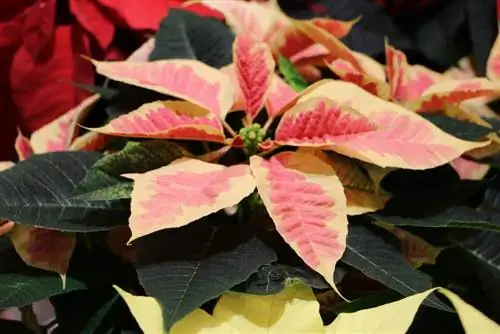
When a potting mix has passed its “loose stage”, you can water as much as you want, the water no longer benefits the plant, but simply runs through. Before you repot the plant in proper soil, you don't need to worry about the frequency of watering.
The flower pot or bucket
The material of the flower pot / bucket also has a significant influence on water requirements and watering behavior:
The plastic pot
The plastic pot does not evaporate moisture, which is a good thing because it saves you water. Maybe with a banana in a tub the size of a bathtub that could really amount to one or two liters, and if you live with hundreds of houseplants, it certainly does. Otherwise, the density of the plastic pot is more of a disadvantage because no moisture compensation can take place. In nature there is often too little water, but never too much water for a normal plant because normal soil, whether poor or nutrient-rich, allows excess water to drain away.
Soil with too high a water content is not soil, but mud in which only aquatic plants can grow. This is also how your houseplants see it. If the water drain in a plastic pot becomes blocked, this is the death of many moisture-sensitive plants. If the plastic pot is left in the sun, it may cook off the roots of the plant a little, which many plants don't like at all. There is probably no need to go into detail about the poor ecological balance of plastic pots and their dubious decorative value.
The clay pot
If you use a clay pot, you don't have all these problems, on the contrary, the natural material “helps you with watering”. Clay flower pots can absorb excess moisture and release it to the outside through evaporation. This uses a little more water, but really only slightly more. But it is good for the indoor climate, and most houseplants are purchased to improve the indoor climate.
The clay pot is good for the plant anyway, its water balancing function protects against wet feet in case of doubt, and the diffusion-open clay wall creates a good, oxygen-rich climate in the root area. Clay is a natural component of the soil and contains nutrients, which the plant also gets some of.
The following applies to watering houseplants in clay pots: It's completely normal as described above, but you have to be much less careful than with plants in plastic pots.
The pot size
The pot size also has an influence on whether a plant can develop a balanced water balance if artificial irrigation is carried out largely correctly.
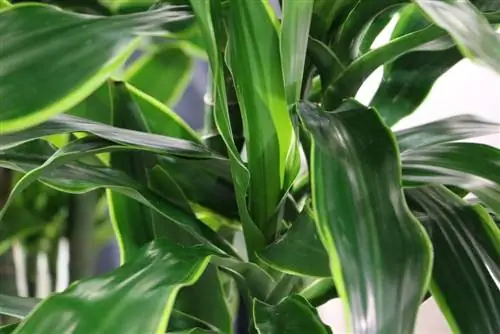
Scientists recently calculated that houseplants would grow best if they were given one liter of pot volume per gram of dry biomass - that would be roughly the size of the mortar for the cyclamen. Of course no one does that, if only for optical reasons, but it would also be fatal if the cyclamen, for example, B. would be a small aloe. It would then really get started, quickly becoming a meter high and wide, and when it comes to watering, you should think about where the cistern for the irrigation water will be located.
But a certain pot size is necessary so that at least a little water balance can take place - in the wild a plant has a lot of land around it and in a he althy plant community there is also a neighboring plant that provides it with a little moisture via micorrhizal fungi before she dies of thirst. If it doesn't have everything in the pot, you have to replace your plant's nice helper mushrooms and the rest of the natural cycle. It's better if there's some space in the pot, a little water and nutrient storage for emergency supplies. In order to water a plant in a tiny pot just right, you would have to be able to read minds - the thoughts of a plant.
The withered houseplant
When a plant has enough water, it stands beautifully upright in the pot because all the cells are saturated. When water becomes scarce, nothing happens for a while; when the cells are empty and the shoots hang, water is already very scarce. Then there was nothing more to be gained from the soil, not with the last root tip, and with most substrates this meant that simply watering no longer achieved anything.
A little later the roots dry out and now water from above is of no use at all, the life-saving liquid flows through the soil and through the roots and back outside through the drainage hole in the bottom of the pot. Earth and water must now be able to absorb water again.
So that dry roots and hard soil become soft again, they must be soaked in a container of water that is larger than the pot. When the soil becomes saturated, air bubbles will appear. If they don't appear, you can remove the pot to drain.
Other errors when casting
There are still a few little things that can really bother plants when watering:
- If you water houseplants on a south-facing window in summer in the midday heat, you will most likely burn the leaves
- In summer, it's best to water in the morning, and it certainly doesn't have to be between 3 and 4 a.m., as the Federal Association of Retail Gardeners so realistically suggests
- Just do it when it's still cool so that the water doesn't evaporate when you water or become a burning glass on the leaves
- In the evening it is less good if you water the leaves, which then stay wet overnight, mushrooms love that
- Rainwater is not ideal everywhere, but only if it has the right pH value, 6-7, not lower
- It can also be full of germs, especially in summer
- Houseplants on the balcony quickly get too much water when it rains
- The drain has to work really well
- You can also mulch large-leaved “drinkers” in the bucket, which keeps the moisture in the soil
- Mulching also works with decorative granite chips or pebbles
- The watering water should be at room temperature if possible, as some plants react sourly to cold showers
Conclusion
Anyone who understands “watering” as “pouring water over plants” is still a long way from the indoor gardener’s famous “green thumb”. However, once you realize that a certain circumstance plays a role when watering your houseplants and why that is, you will usually no longer have any problems with correct watering.

